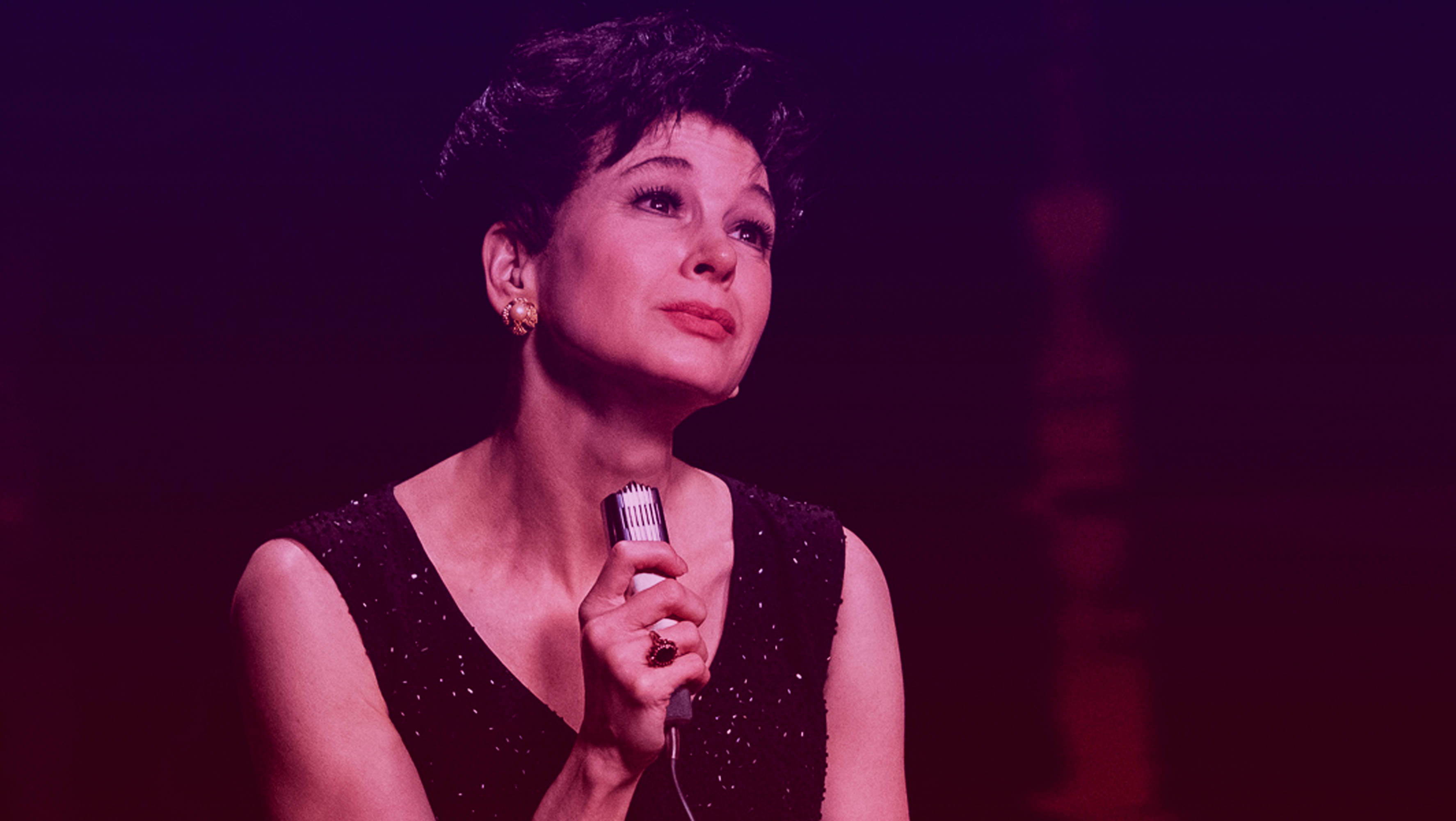There was no one like Judy Garland. Star of classic movie musicals The Wizard of Oz, Meet Me in St. Louis and A Star is Born, she could sing, dance and act circles around most anyone. Her live concerts were renowned for her incomparable voice and the intimate connection she created with her audience. As film director Stanley Kramer once noted, it’s as if she came on stage and said, “Here is my heart. Break it.”
Judy, the heart-rending new biopic of Garland starring Renée Zellweger, explores how one of the greatest-ever entertainers remained trapped in patterns of abuse and addiction that plagued her since childhood. By focusing on the last year of her short life (Garland died of a drug overdose at the age of 47), director Rupert Goold and screenwriter Tom Edge spin a dark tale of despair brightened by exciting concert sequences and flashes of Garland’s indomitable spirit and generous heart. Despite being rooted in history, the movie speaks to our current moment by laying bare accusations at the heart of the #MeToo movement, while illuminating Garland’s continuing importance to LGBTQ2 communities and beyond.
“There’s darkness, certainly,” says Zellweger during an interview at the Toronto International Film Festival in September, “but in my mind, how she rose through it is heroic, what she was able to achieve, in spite of all of that, really sets her apart and highlights how truly extraordinary she was.”
Zellweger gives the performance of a lifetime as Garland who, at 46, is attempting one more comeback with a string of concerts at London’s The Talk of the Town theatre in 1968. Zellweger’s performance summons something deep and true from within her, with deft displays of Garland’s telltale facial and vocal tics, her off-kilter posture and jittery mannerisms. This Garland is a damaged but loving woman—a single mother with no money, trying to maneuver through a nightmare of legal, financial and personal roadblocks in order to reunite with her two young children. She’s running on fumes. All she has left is sheer willpower and that awesome voice, diminished but still amazing.
“I just wanted to understand and sort of fill in the blanks between the public record and speculation,” says Zellweger. “Because there’s always more to a story than just the tragedy of a person’s life. I wanted to understand the omissions of her critics.”
Goold makes audiences wait 45 minutes before letting Garland—and Zellweger—sing. It’s a fantastic choice, one that ratchets up the tension. Both the fictional audience and the movie audience are left wondering, “Can she do it?” It’s an approach Goold honed during his many years directing live theatre; he’s currently artistic director of the Almeida Theatre in Islington, London, with only one other feature film to his credit, 2015’s True Story.
“There’s something about being in a rehearsal room or small space with opera singers or musical performers or actors,” says Goold, “that is a specific privilege of a director. You see [artists] in their most vulnerable states when they are creating.”
“Zellweger’s voice isn’t Garland’s—whose could be?—but it’s a good voice, delivering both joy and pathos”
That vulnerability is on full display in the film’s first musical sequence. Garland, who suffered from serious stage fright her whole life, arrives late for the concert and stands unsteady in the wings. The whole movie lives in that moment, that threshold between performer and performance, when Garland summons some internal power and finally steps onstage. “I wanted it to cost something and be a risk,” says Goold. “And I know that Renée in that shot is terrified,” he says, laughing.
The first song, “By Myself,” has an aura of combat about it, a feeling reinforced by Goold’s swooping camera movements that charge forward for close-ups like a bull to a cape. It’s as if Goold is daring audiences to find fault with Zellweger, who does all her own singing, often in single takes, recorded live. Zellweger’s voice isn’t Garland’s—whose could be?—but it’s a good voice, delivering both joy and pathos in this and other musical numbers that are smartly stitched into the drama. It’s a bravura performance all round, sure to garner Zellweger an Oscar nomination.
The fact that Judy Garland, the darling of MGM in the 1930s and ’40s when the studio was run by Louis B. Mayer, is portrayed by Renée Zellweger, the darling of Miramax in the 1990s and 2000s when the studio was run by Harvey Weinstein, shows how far and how little we’ve come over the past 80 years.
Using End of the Rainbow, Peter Quilter’s Tony-nominated play from 2012 about Garland, as a starting point, screenwriter Edge fleshes out Garland’s motivations by adding flashbacks to her early years at MGM (a wonderful Darci Shaw plays young Judy). As a teenager, Garland was bullied by studio executives, denigrated about her looks and weight, touched inappropriately by Mayer and fed a toxic cocktail of diet pills, uppers and downers to keep her thin and hard at work. Garland made at least 28 films during her 15 years at MGM. The yellow brick road was a hellish highway.
Considered a founder of Hollywood’s studio system, Mayer is now also cited as helping to establish Hollywood’s system of sexual abuse. He was a law unto himself, ruling his empire with impunity: Pimping out young women, forcing actresses to have abortions, controlling his stars’ personal lives, covering up scandals and employing a host of enforcers, blackmailers and spin doctors. While Mayer himself may not have been the most egregious sexual predator, the accusation that he repeatedly fondled a young Garland comes from her own unfinished, unpublished memoir discovered by biographer Gerald Clarke, who detailed her life in his 2000 book Get Happy: The Life of Judy Garland.
Like Mayer, Weinstein was a powerful Hollywood hitmaker. His company, Miramax, was behind award-winning films like Good Will Hunting, Pulp Fiction and Shakespeare in Love. In 2017, the New Yorker and the New York Times revealed numerous allegations of rape and sexual abuse against Weinstein. More than 80 women have since come forward. Last year, Weinstein was charged in New York with rape and sexual assault; he is currently out on bail. Other criminal investigations are ongoing.
Zellweger, who starred in the Weinstein-backed films Bridget Jones Diary, Chicago and Cold Mountain, has said she was never abused by him and has denied allegations said to have been made by Weinstein that she gave him “sexual favours.”
When asked how she relates to Garland’s tortured existence, Zellweger, who stepped away from acting in 2010 for six years, makes clear the differences that separate her life from Garland’s. “I don’t have the same circumstances, where people have been stealing from me, or that I’ve been through complicated relationships that leave me in dire straights, children that you have to take care of, you know?
“It’s very different, obviously,” she says. “In this age, a woman has autonomy and ability to participate in the course of her professional career. Not so much then. But pressure? Sure. Not by Louis B. Mayer, but self-imposed sometimes… forgetting to take care of yourself, that’s relatable. You can’t even see it until you’re removed from it. And the difference, the vast gulf, between a public persona and the truth of a person’s life and existence and how they perceive themselves, I understand that.”
Early-on in development, Judy’s creators knew they wanted to speak to Garland’s connection to the gay and trans communities. It was Edge who came up with the idea that Garland would meet a gay couple, fans she encounters at the stage door, who could represent the passionate bond Garland had with her audiences, especially her gay audience.
Present-day gays might be shocked at this hapless, shambling couple (played by Andy Nyman and Daniel Cerqueira). Looking old beyond their years, they’re as beat up as Garland. Their devotion to her is palpable, urgent. When one divulges that his partner had been jailed on obscenity charges, Garland reacts angrily. “They hound people in this world, anybody who is different. They can’t stand it. Well, to hell with them.” Of course she’s speaking about herself, too, and that identification is one of the connections between Garland and her LGBTQ2 fans.
“Gay men turned out in droves to see Garland. Her concerts were one of the few places outside of bars where they could congregate”
Gay men turned out in droves to see Garland. Her concerts were one of the few places outside of bars where gay men congregated together in the 1950s and ’60s, a fact she sometimes acknowledged from the stage. So great was the community’s affection toward her that Garland’s death is often cited as the beginning of the modern LGBTQ2 rights movement. The Stonewall riots in New York began the night of her funeral, when gay men, trans women and other queers fought back against police harassment—though many historians have challenged the Garland connection to the uprising. Still, for many queer people of a certain age, Judy Garland helped put the rainbow in our flag.
But why Judy? Why her over all the other divas LGBTQ2 folk love? It wasn’t just that her father was gay, that two of her five husbands were gay and that her musical trainer and arranger was gay. Something more profound was going on.
Perhaps it was her many tragedies and struggles. When Garland was fired from MGM in 1950, she attempted suicide. It wasn’t the first time, but without the MGM spin machine behind her, the story went public. The press dragged Garland’s squeaky clean image through the mud. She was no longer innocent Dorothy Gale nor Andy Hardy’s sweetheart. She was a drug addict, an emotional wreck, an outcast. That’s when the gay connection really took root. Garland was a reject who fought her way back in.
“Repeated comebacks in the face of social disgrace, that’s why the gay community loved her”
Her first comeback: The 1951 concerts at London’s Palladium and NYC’s The Palace, followed in 1954 by her Oscar-nominated performance in A Star is Born. But health scares and emotional and financial troubles continued. Then, another comeback: Her Carnegie Hall performances in 1961 and the resulting multiple Grammy-winning double album, Judy at Carnegie Hall; her Oscar-nominated performance in Judgment at Nuremberg (directed by Stanley Kramer) was also in 1961. Repeated comebacks in the face of social disgrace—that’s why the gay community loved her.
And not just gay people. “I feel that affection, too,” says Zellweger. “We dream with her, we discover ourselves with her, we find that, ‘Oh wait, I’m different. But I’m enough,’ with her. Those are big themes. She resonates with me too, you know? And on a personal level, on reading this [script], I felt so much love for her and I felt empathy and I felt outrage.”
The deepest connection between Garland and LGBTQ2 folks can be found in how she mined her own troubles, made them part of her repertoire and onstage banter. By bringing her defeats and heartbreak onstage with her, she wrote her life into the act. So when she triumphed onstage, she triumphed in life, too. That’s camp—the uniquely queer point of view that unites authenticity and theatricality, that understands how masks reveal as much as they hide.
“She’s probably one of the first who, as a child star, lived her life in front of the camera until her later years,” says Zellweger. “And that scrutiny and that sense of needing to deliver, it was her identity.”
Judy doesn’t just exploit the porous membrane between performer and performance, it wraps Garland in it like a blanket. On stage, Garland gave her all.
“What is it about her that connects?” asks Goold. “I think that throughout her career she had a huge emotional availability, a transparency. There’s no mask. There’s just her.”
Judy opens in theatres Friday, Sep. 27.


 Why you can trust Xtra
Why you can trust Xtra


